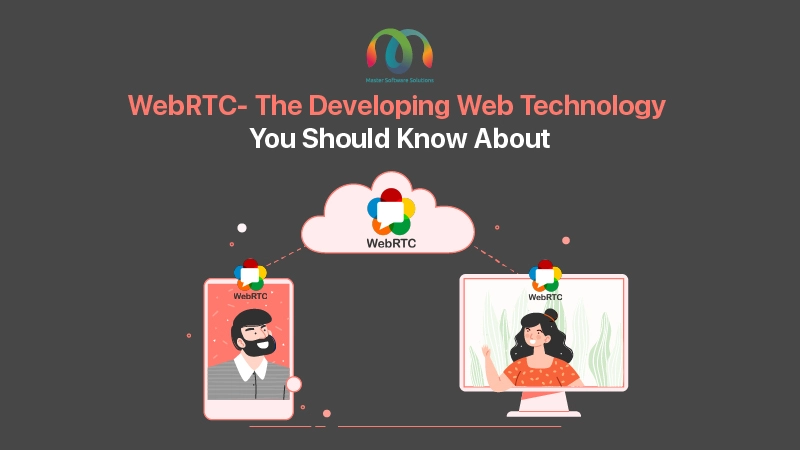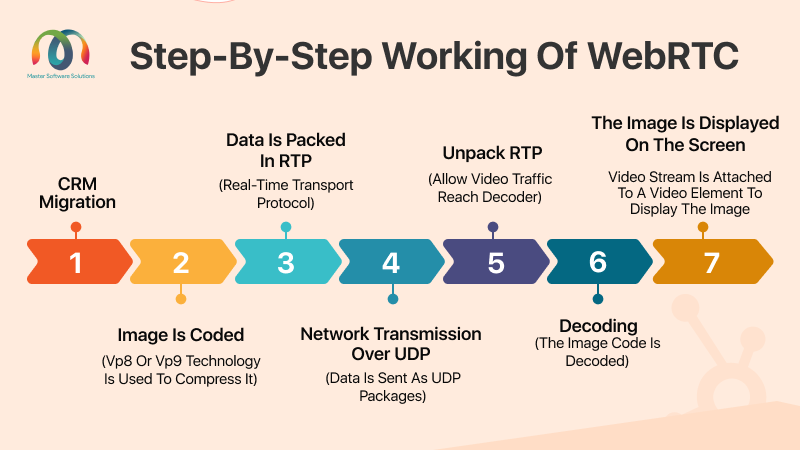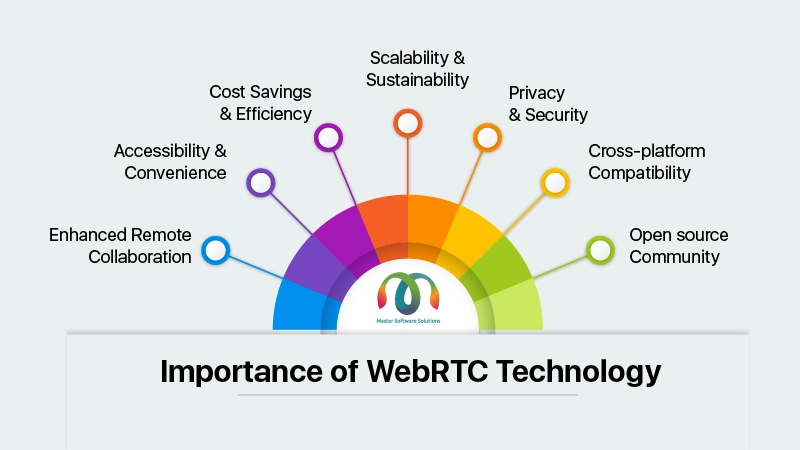WebRTC- The Developing Web Technology You Should Know About

The Web has undergone significant changes over the years, and WebRTC (Web Real-Time Communication) is one of the most exciting innovations. If it is not common knowledge, WebRTC application development services are the most potent for developing web services that permit real-time communication within web browsers. WebRTC is transforming how we communicate and collaborate online, from video conferencing and voice calls to screen sharing and file transfer.
What is WebRTC (Web Real-time Communication)?
WebRTC is an open-source project with APIs (application programming integrations) with real-time communication over voice, video, and text capabilities between the browser and devices. WebRTC developers use these APIs to establish peer-to-peer communications between Internet web browsers and mobile applications.
The Evolution of WebRTC
WebRTC is not just another tech industry abbreviation. Real-time communication and external plugins or applications represent a significant advancement in web technology.
Let’s take a quick look at its evolution:
- Origins – Google created WebRTC for the first time in 2011, intending to enable real-time voice and video communication within web browsers. Late from all over the world to contribute and advance it.
- Standardisation – WebRTC underwent a standardisation process by the Internet Engineering Task Force (IETF) and the World Wide Web Consortium (W3C) to guarantee interoperability across various browsers and platforms.
- Cross-browser compatibility – Major web browsers, such as Google Chrome, Mozilla Firefox, and Microsoft Edge, have adopted and implemented support for WebRTC over time. As a result, a sizable user base can now access WebRTC.
Applications of WebRTC
Real-time capabilities and WebRTC’s adaptability have made it a popular choice for integration across sectors and applications.
Features of WebRTC (Real-time communication)
WebRTC (Web Real-Time Communication) offers features for seamless and secure real-time communication experiences across web browsers and mobile devices. They empower developers to build a wide range of innovative applications and services.
Some of the features of WebRTC include:
- Peer-to-Peer Communication – Browsers or devices can connect directly to each other without the use of middle servers with WebRTC peer-to-peer communication.
- Get User Media API – This API gives users access to audio and video streams from devices, like microphones and cameras.
- Data Channel – WebRTC has a data channel that allows peer-to-peer communication with any data type.
- Cross-Platform Compatibility – Most web browsers, including Google Chrome, Mozilla Firefox, Safari, and Microsoft Edge, and mobile platforms like Android and iOS support WebRTC.
- Adaptive Bitrate Control – WebRTC supports adaptive bitrate control, which dynamically adjusts the quality of audio and video streams based on network conditions.
- DTLS and SRTP – WebRTC uses encryption to ensure secure peer-to-peer communication.
How does WebRTC technology work?
The WebRTC technology uses JavaScript, APIs, and Hypertext Markup Language (HTML) that embed communication technology into web browsers and native apps (iOS and Android) to create audio, video and data communication applications.
Steps involved in the technology:
- When two users have different IP addresses, a NAT firewall prevents them from communicating in real-time, WebRTC with the session transversal utilities for NAT (STUN). STUN translates an IP address into a public Internet address to establish a peer-to-peer connection.
- When the users have more restrictive networks that STUN can not establish, WebRTC is used with the Transversal Using Relays Around NAT (TURN) server to relay traffic between users. An interactive connectivity establishment protocol finds the best connection.
Step-by-step working of WebRTC
Apps with WebRTC
Front-end
- WebRTC Native APIs – The native apps are written in C++ and covered by a 3-clause BSD licence. WebRTC also offers Software Development Kits (SDKs) for Android and iOS.
- GStreamer – It is a dynamic media pipeline framework that supports plugins and is LGPL-licenced. It is developed in C and based on the Gobject type system. GStream offers an object-oriented model that is easy to work on.
Additional abandoned repositories are available for implementing WebRTC on different platforms based on Libjingle.

Backend
Developing the backend requires a sophisticated architecture that includes three components:
- Multi-media server
- Signalling server
- TURN/ STUN servers
Does WebRTC application development require technical knowledge?
Yes. Developing WebRTC applications requires technical knowledge, especially in web development, networking, and real-time communication protocols. WebRTC (Web Real-Time Communication) is a free, open-source project that enables audio, video, and data in web browsers and mobile applications. WebRTC requires technical expertise in web development, networking, real-time communication, security, APIs and libraries, and testing and debugging.
If you have these technical skills, you can develop WebRTC solutions yourself. Or, you can also opt to partner with third-party WebRTC development services, from which you can hire WebRTC developers.
WebRTC development services offered
- WebRTC Mobile App Development – This service entails developing mobile applications (for iOS and Android platforms) that use WebRTC technology to enable real-time communication capabilities. These apps could include features like video calls, voice calls, and data sharing built into the app, using WebRTC APIs and libraries to enable peer-to-peer communication.
- WebRTC Web Application Development – This service specialises in developing web applications that use WebRTC functionality to enable real-time communication directly within the web browser. WebRTC allows for video conferencing, screen sharing, file transfer, and other features that do not require additional plugins or software installations. WebRTC web applications can be accessed using any device that has a compatible web browser.
- WebRTC API Development – This service entails creating custom APIs (Application Programming Interfaces) that use WebRTC technology. These APIs integrate real-time communication features into existing applications or platforms, enabling developers to build custom solutions tailored to their requirements.
- WebRTC Multi-platform Streaming – This service involves developing applications or platforms that support multi-platform streaming using WebRTC technology. It includes streaming live video and audio content to multiple devices simultaneously for various platforms such as web browsers, mobile devices, smart TVs, and more.
- Live video streaming app development – This service focuses on building applications for live video streaming, leveraging WebRTC technology for real-time transmission of video content. These apps serve various purposes, such as live events, video conferencing, online education, gaming, and social networking.
- Webinar and event broadcasting – This service involves developing platforms or applications for hosting webinars, online events, and broadcasts using WebRTC technology. These platforms typically offer live video streaming, interactive chat, screen sharing, audience engagement tools, and analytics to facilitate virtual events and conferences.
Benefits of WebRTC application development
WebRTC (Web Real-Time Communication) application development offers several benefits, making it an attractive choice for building real-time communication solutions.
Some of the benefits of WebRTC application development
- Real-time Communication – WebRTC enables real-time communication directly within web browsers and mobile applications, eliminating the need for plugins or other software.
- Low Latency – WebRTC lowers latency in communication, ensuring that data is transmitted and received with minimal delay.
- Security – WebRTC uses encryption mechanisms to ensure peer-to-peer communication is secure. Datagram Transport Layer Security (DTLS) encrypts data streams sent between peers, ensuring confidentiality and integrity.
- High-Quality Audio and Video – WebRTC supports high-quality audio and video streaming, allowing users to communicate using clear, crisp audio and video streams.
- Scalability and Flexibility – WebRTC is scalable and flexible, enabling developers to create applications ranging from simple one-on-one calls to large-scale video conferencing platforms or live streaming events.
- Easy Integration – WebRTC provides simple APIs for integrating real-time communication features into web and mobile applications.
Here are some notable applications:
- Video conferencing – Platforms for video conferencing are where WebRTC is employed. WebRTC enables services like Zoom, Microsoft Teams, and Google Meet to offer seamless video calls with low latency and high-quality audio and video.
- Voice calls – WebRTC makes it possible to make voice calls from web browsers, eliminating the need for separate phone applications. VoIP (Voice over Internet Protocol) solutions and customer support services can benefit.
- Screen sharing – Collaborative work has become more practical with the screen sharing feature. Users can share their screens during meetings to present ideas, troubleshoot issues, and provide remote instruction.
- File transfer – WebRTC supports file transfers right in the browser. This feature helps share documents, images, and other types of files without using third-party services.
- Gaming – WebRTC enables voice chat in-game and in-game multiplayer interactions. Players can communicate with their teammates and plan strategies without leaving the game environment.
- Telehealth – The technology has been adopted as telehealth by the healthcare sector. Patients have better access to medical services through video calls with healthcare professionals.
- IoT (Internet of Things) – WebRTC is being incorporated into IoT devices, enabling users to remotely monitor and control smart devices like security cameras and home automation systems.
Why does WebRTC matter in 2024?
As the digital era progresses, WebRTC’s importance becomes clear:
- Enhanced remote collaboration – WebRTC is a crucial enabler of the shift towards remote work and virtual collaboration. It provides the tools for teams to communicate effectively, regardless of location.
- Accessibility and convenience – WebRTC eliminates the need for users to download and install additional software by bringing communication tools right into web browsers. Real-time communication solutions are accessible for people and organisations to adopt and use because of their accessibility and convenience.

- Cost savings and efficiency – WebRTC eliminates the need for third-party communication services, cutting the costs of conventional telephony and conferencing solutions. The technology is an appealing option for companies looking to reduce communication costs.
- Scalability and sustainability – WebRTC is appropriate for small and large businesses as it is highly scalable. Due to its flexibility, it can adapt to the changing needs of businesses.
- Privacy and security – In the digital world, security is very crucial. WebRTC uses encryption protocols to safeguard data while transmitting, guaranteeing the confidentiality of sensitive information.
- Cross-platform compatibility – Major web browsers’ adoption of WebRTC makes it compatible with operating systems and devices, providing a consistent user experience.
- Open source community – The open-source nature of WebRTC encourages creativity and ongoing development. Programmers support its growth, ensuring that the technology remains cutting-edge.
WebRTC is a technological advancement that revolutionises how we communicate and work together online. Hiring webRTC developers allows businesses to bridge the gap between people, devices, and businesses in 2024 and beyond as remote work and virtual interactions continue to gain importance. Applications-wise, benefits-wise, and innovation-wise, it has virtually endless potential. WebRTC is a technology that should be on your radar if you are a business owner or just an internet user because it is changing the digital landscape. Therefore, by keeping an eye on WebRTC’s development, you can be well-prepared for real-time web communication in the future.
Process followed in WebRTC development in Master Software Solutions
We focus on understanding our customers’ needs to form a collaborative partnership between us. We believe in open communication and welcome feedback, with transparency as our core value.
- Initial Consultation – The initial consultation includes understanding your goals, requirements, and challenges.
- Requirement Analysis – We conduct a thorough requirements analysis to determine the project scope.
- Architecture and Development – We develop a comprehensive architecture and design for your WebRTC solution based on the requirements analysis.
- Integrations and Testing – As development progresses, we focus on integrating various WebRTC solution components and performing rigorous testing to ensure functionality, performance, security, and compatibility.
- Deployment – After testing and validation, we put your WebRTC solution into production.
- Support and Maintenance – We offer reliable support and maintenance services to keep your WebRTC solution running smoothly.
Are you looking for WebRTC application development services? Then you are in the right place. We offer an array of WebRTC development services. Contact us to discuss your requirements and see how we can help.
